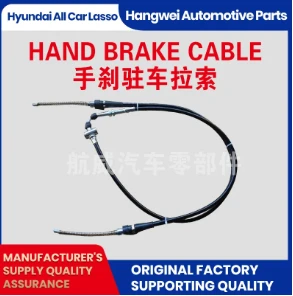gear linkage cable
Understanding Gear Linkage Cables A Key Component in Automotive Performance
In the realm of automotive engineering, every component plays a vital role in ensuring smooth operation and optimum performance of a vehicle. One such crucial component is the gear linkage cable. This seemingly simple part facilitates the interaction between the gear shifter and the transmission, enabling the driver to shift gears seamlessly. Understanding the function, construction, and maintenance of gear linkage cables is essential for anyone looking to enhance their vehicle's performance or undertake DIY repairs.
What is a Gear Linkage Cable?
A gear linkage cable is a flexible conduit that connects the gear shift lever inside the vehicle to the transmission system. It translates the physical movement of the gear shifter into corresponding actions within the transmission, allowing the driver to change gears smoothly. The design of gear linkage cables can vary depending on the vehicle make and model, but they generally consist of a durable outer casing and a flexible inner cable that transmits the motion.
Functionality of Gear Linkage Cables
The primary function of gear linkage cables is to convey the driver's intention to change gears into a mechanical action that the transmission can understand. When a driver moves the gear lever, the linkage cable pulls or pushes the transmission selector mechanism, which then engages or disengages the appropriate gear. This process must occur effortlessly to provide a smooth driving experience, making the quality of the gear linkage cable paramount to overall vehicle performance.
Construction and Materials
Gear linkage cables typically incorporate a combination of metals and plastics to maximize durability while minimizing weight. The outer casing is often made from a robust plastic material that can withstand extreme temperatures and environmental conditions. The inner cable is typically constructed from high-strength steel, allowing for flexibility and resistance to wear and tear. High-quality gear linkage cables are designed with safety features, such as inner lubricants, to reduce friction and promote longevity.
Signs of Wear and Tear
gear linkage cable

Over time, gear linkage cables may experience wear and tear, leading to shifting issues. Drivers may notice symptoms such as difficulty in changing gears, unusual noises when shifting, or the gear shifter feeling loose or disconnected. It’s essential to address these issues promptly, as ignoring them can lead to more severe transmission problems and costly repairs.
Maintenance Tips
To ensure the longevity and proper functioning of gear linkage cables, regular maintenance is key. Here are some tips to keep in mind
1. Routine Inspection Periodically check the condition of the gear linkage cable, looking for signs of fraying, corrosion, or wear. Early detection can prevent more significant issues down the road.
2. Lubrication Applying appropriate lubricants to the cable can reduce friction, ensuring smooth operation. However, it’s essential to use lubricants recommended by the vehicle manufacturer to avoid damage.
3. Professional Checkup If you’re unsure about the condition of your gear linkage cable or you notice shifting issues, it’s wise to consult a professional mechanic. They can perform a thorough inspection and advise on repairs or replacements, if necessary.
Conclusion
Gear linkage cables are a fundamental component of any vehicle's transmission system, playing a crucial role in ensuring effective gear changes and a smooth driving experience. As with any vehicle component, understanding their function and maintaining them properly can help prolong their lifespan and enhance overall vehicle performance. Whether you are a seasoned driver or a car enthusiast, being aware of the importance of gear linkage cables can aid in making informed decisions regarding vehicle maintenance and repairs. Investing time in understanding this essential aspect of automotive engineering ensures that your vehicle continues to perform at its best, providing you with the reliability and performance you expect on the road.
-
Workings of Clutch Pipe and Hose SystemsNewsJun.04,2025
-
The Inner Workings of Hand Brake Cable SystemsNewsJun.04,2025
-
The Secrets of Throttle and Accelerator CablesNewsJun.04,2025
-
The Hidden Lifeline of Your Transmission Gear Shift CablesNewsJun.04,2025
-
Demystifying Gear Cables and Shift LinkagesNewsJun.04,2025
-
Decoding Clutch Line Systems A Comprehensive GuideNewsJun.04,2025
